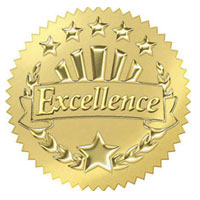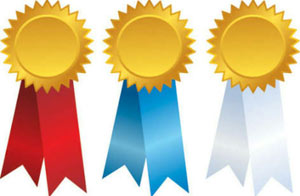Among several initiatives of the Indian Merchants' Chamber, a significant one was the setting up of Quality Improvement & Technology Committee in 1993 and the Quality Cell. This Expert Committee – chaired by Mr. Niraj Bajaj – instituted the IMC Ramkrishna Bajaj National Quality Award (IMC RBNQA) Trust to administer the Award with a purpose of spreading awareness for quality and fostering competitiveness in Indian Industry.
At the Indian Merchants’ Chamber (IMC) we see the Ramkrishna Bajaj National Quality program as a catalyst for nation-building. The aim was to match the stature of international awards such as Malcolm Baldrige, the European Award and the Deming Prize in terms of rigorous criteria and standards of excellence. It was thought appropriate that this Award be named after the Late Mr.Ramkrishna Bajaj whose motto was “Trust in Quality and Business Ethics”. During his lifetime, he not only led the Bajaj House of Business to higher pinnacles of glory and prosperity but also spearheaded the Quality Movement in the country in several ways.
The younger son of Jamnalal and Jankidevi Bajaj, Ramkrishna Bajaj was essentially a product of the freedom movement. Brought up under the personal guidance of Mahatma Gandhi and Acharya Vinoba Bhave since his childhood, he participated in the freedom struggle and spent more than three years in jail. He became the Head of the Bajaj Group after the passing away of his elder brother, Kamalnayan Bajaj. He was more of a business leader than a businessman. For him, being a part of the nation-building process was as important as running his business. Concerned about the morality in public life, he concentrated on making businessman aware of the need to fulfil their larger social responsibilities. He was also known for his deep involvement in social work and philanthropy.
Apart from his socio-economic activities at the national and international levels, he established various foundations and institutions for promoting social welfare and Gandhian constructive activities. He was particularly concerned with ethics in business, business self-regulation, and consumer welfare. He was the President of FICCI, Indian National Committee of the International Chamber of Commerce and IMC. He was the Chairman and Founder of various industry and trade organizations such as the Council for Fair Business Practices and the National Center for Quality Management.
Categories of Award
There are six applicant categories for the IMC Ramkrishna Bajaj National Quality Award:
Categories 1-4 come under Business Excellence
Business Excellence
Manufacturing, Service, Small Business and Overseas are the four categories under Business Excellence. When we talk of Business Excellence we refer to excellence in any for-profit business headquartered in India, including Indian subunits of foreign companies, as well as any for-profit Indian owned business headquartered overseas. For-profit businesses include domestic or foreign-owned companies, joint ventures, corporations, sole proprietorships, partnerships, and holding companies-publicly or privately owned.
Manufacturing organizations
Manufacturing, Service, Small Business and Overseas are the four categories under Business Excellence. When we talk of Business Excellence we refer to excellence in any for-profit business headquartered in India, including Indian subunits of foreign companies, as well as any for-profit Indian owned business headquartered overseas. For-profit businesses include domestic or foreign-owned companies, joint ventures, corporations, sole proprietorships, partnerships, and holding companies-publicly or privately owned.
Service organizations
Organizations and some subunits that provide or sell services.
Note: Where an applicant is both a manufacturer and a service provider, the appropriate eligibility category is the activity that provides the larger percentage of sales.
Small Businesses
Organizations with 200 or fewer employees that are engaged in manufacturing and/or the provision of services.
Overseas organizations
Indian organizations that are engaged in manufacturing and /or the provision of services.
Excellence in Education
For-profit and non profit public, private, and government organizations and some subunits – including Indian subunits of foreign organizations that provide education (teaching and instructional) services to students in India, as well as Indian educational organizations located overseas.
Note: For-profit education organizations may choose to apply under the service or small business or overseas business category, as appropriate, using the Business Criteria, or under the Education category, using the Education criteria.
Excellence in Health Care
For-profit and non profit public, private, and government organizations and some subunits – including Indian subunits of foreign organizations located in India, as well as Indian healthcare organizations located overseas. These organizations must be engaged primarily in providing medical, surgical, or other health care services directly to people. Eligibility is intended to be as open as possible. For example, eligible organizations include hospitals, health maintenance organizations, long-term care facilities, health care practitioners’ offices, and dialysis and ambulatory surgery centres.
Note: For-profit health care organizations may choose to apply under the service or small business or overseas business category, as appropriate, using the Business Criteria, or under the health care category, using the Health Care Criteria available at www.imcrbnqa.com. When an applicant is both an education organization and a provider of health care services to people, the appropriate eligibility category is the activity that represents the larger percentage of its budget.
Award Cycle Dates
| Award Cycle | Date |
|---|---|
| Eligibility Determination Forms | May |
| Award Application 65 Pg Report | August |
| First Stage Review | August - September |
| Consensus Review | September - October |
| Site Visit Review | October - November |
| Feedback Reports Submission | November |
| Shortlist for Judges | November |
| Role Model Determination | December |
| Judges Final Review | January |
| Announcement of Awards | January |
| Feedback Reports Distribution | January |
| Awards Ceremony | February - March |
Rajiv Gandhi National Quality Award was instituted by the Bureau of Indian Standards in 1991, with a view to encouraging Indian manufacturing and service organizations to strive for excellence and giving special recognition to those who are considered to be the leaders of quality movement in India. This award is intended to generate interest and involvement of Indian Industry in quality programmes, drive our products and services to higher levels of quality and equip our Industry to meet the challenges of domestic and International markets.
The award has been named after our Late Prime Minister Rajiv Gandhi, recognizing the new thrust he had given to the quality movement in India so that India could move into 21st Century with pride.
Rajiv Gandhi National Quality Award would help Indian Industry to improve quality by:
The award has been designed in line with similar awards in other developed countries, like Malcolm Baldrige National Quality Award in USA, Deming Prize in Japan and European Quality Award.
FREQUENCY
Rajiv Gandhi National Quality Award is an annual feature on the basis of financial year. The 2008 award will be considered for results achieved by the organization from 1 April to 31 March.
BENEFITS TO THE APPLICANT ORGANIZATIONS
BENEFITS TO THE AWARD WINNERS
AWARDS AND COMMENDATION CERTIFICATES
There are five awards consisting of one for large scale manufacturing organizations, one for small scale manufacturing organizations, one for large scale service sector organizations, one for small scale service sector organizations and one for BEST OF ALL. In addition, there are eight commendation certificates each for large scale and small scale manufacturing organizations as per industrial sectors given below:
Further, there are six commendation certificates each for large scale and small scale service organizations in the following sectors:
The number of awards/commendation certificates indicated above is maximum. In the event of non-availability of suitable applicants as per assessment criteria decided by the National Awards Committee (NAC), any of the above awards/commendation certificates may not be given.
The BEST OF ALL award consists of a certificate and a plaque, gold plated silver salver of 25 cm diameter. The plaque will be inscribed with logo `Q' in oval shape containing a line profile of late Rajiv Gandhi. It will also bear the inscriptions `Rajiv Gandhi National Quality Award, 2008 - BEST OF ALL' and the name of the winning organization. In addition, the winner will also be given financial incentive in the form of a cash award of Rs. 500 000.
The other awards will consist of a certificate and a plaque, silver salver of 20 cm diameter. The plaque will be inscribed with logo `Q' in oval shape containing a line profile of late Rajiv Gandhi. It will also bear the inscriptions `Rajiv Gandhi National Quality Award, 2008 - Category' and the name of the winning organization. In addition, the winners will also be given financial incentive in the form of a cash award of Rs. 100 000 each.
The commendation certificate will consist of a certificate and a plaque, silver salver of 15 cm diameter. The plaque will be inscribed with logo `Q' in oval shape containing a line profile of late Rajiv Gandhi. It will also bear the inscriptions `Rajiv Gandhi National Quality Award, 2008 – Commendation (Industrial Sector)' and the name of the winning organization. In addition, the recipients of commendation certificates will also be given financial incentive in the form of a cash award of Rs. 50 000 each.
ELIGIBILITY TO COMPETE FOR THE AWARD
An organization is eligible to compete for the award, if it satisfies all the following conditions:
A Sub-unit which performs only support functions for the parent organization such as, sales, marketing, distribution, finance, human resources and health are not eligible. [A Sub-unit is a Unit or Division of a larger organization (Parent organization) which owns or has organizational and/ or financial control of sub-unit]
Further, if an applicant organization has earlier received an award, it is not eligible to apply for an award for next three awards. However, this condition will not apply to those applicant organizations which have received commendation certificate.
ASSESSMENT CRITERIA
The assessment for large scale organization will be made on the basis of nine parameters, namely, Leadership; Policies, Objectives and strategies; Human resource management; Resources; Processes; Customer focused results; Employees’ satisfaction, Impact on environment and society; and Business results.
The assessment for small scale organization will be made on the basis of six parameters, namely, Leadership; Human resource management; Processes; Customer focused results; Impact on environment and society; and Business results.
Emphasis will be placed on quality achievement and quality improvement as demonstrated through the information provided by applicant organization.
ASSESSMENT PROCESS
All the applications received shall be screened as per the criteria laid down on the basis of information provided by the applicant organization. Applicants selected in preliminary screening will become eligible for fact-finding and evaluation visits. A team of experts appointed for this purpose would visit the applicant organization for on-the-spot study and evaluation.
The Foundation for the Malcolm Baldrige National Quality Award was created to provide the private sector a means of accomplishing the following Award objectives: a) raise sufficient funds to establish an endowment which, when supplemented by fees from Award applicants, would permanently fund the Program; b) oversee the investment of endowment funds; c) review Program accomplishments; d) disburse required funds to the National Institute of Standards and Technology (NIST); and e) review the plan and approve associated funds requirements for subsequent years to ensure a successful Award program.
The Foundation has no oversight of the Baldrige program and has no involvement in the award process.
Originally, three types of organizations were eligible: manufacturers, service companiesand small businesses. In 1998, the President and the U.S. Congress approved legislation that made education and health care organizations eligible to participate in the Award Program in 1999. Finally, in 2006 the President and the U.S. Congress approved legislation that made non-profit organizations (including charities, trade and professional associations, and government agencies) eligible to participate in the Award Program in 2007. The award promotes excellence in organizational performance, recognizes the achievements and results of U.S. organizations, and publicizes successful performance strategies. The award is not given for specific products or services.
Leaders of prominent organizations have been selected to serve as Foundation Trustees to ensure that the Foundation’s objectives of supporting the Award process are accomplished. In addition, a broad cross-section of organizations from throughout the United States provides financial support to the Foundation.
Guiding Principles
Adopted October, 2007 by the Foundation for Malcolm Baldrige National Quality Award, Inc. Board of Directors
In recognition of the need for the Foundation to strive to maintain the public trust in fulfilling its respective charitable purposes, the Baldrige Foundation Board of Directors has adopted the following Principles as a condition of membership. Members are asked to endorse these Guiding Principles that set forth ideals for each member to work to achieve and demonstrate in the operations of the Foundation.
The Guiding Principles address the question – what does the Foundation stand for? The following four guiding principles reflect aspirations for good governance, stewardship, and continued assurance of the use of private philanthropic money for the good of the Baldrige National Quality Award Program.
GOVERNANCE
Board Members understand and embrace their responsibility to oversee the mission, strategic direction, finances, By-Laws and operations of the Foundation with honesty and integrity. They establish clear and understandable policies addressing key operational concerns, such as conflict of interest, investment and audit policies, as well as fundraising efforts.
Effective Practice Options may include, but are not limited to:
A) Maintaining policies and practices, such as a written code of ethics, a conflict of interest policy, Foundation By-Laws, and oversight of donor intent;
B) Conducting a periodic review of the Foundation’s policies, funding practices, values and mission statements, objectives and strategies;
C) Completing an annual review of the Executive Director (ED) to improve the confidence, support, growth and working relationship between the Board and the ED.
D) Providing leadership for continuity and plan for transitions in Board membership;
E) Ensuring the Foundation’s governing body members have the requisite skills and experience to carry out their duties, which can include;
STEWARDSHIP
Board Members manage and grow the resources of the Foundation Endowment to maximize philanthropic purposes and actively avoid unnecessary expenses. They pursue public benefit through their own philanthropic goals, procedures and by supporting the work of partners, colleagues and trustees.
Effective Practice Options may include, but are not limited to:
Effective Practice Options may include, but are not limited to:
A) Creating a compensation policy for all staff;
B) Ensuring that expenses are reasonable and adhere to federal guidelines for foundations;
C) Encouraging Board Members to serve the Foundation as volunteers or for reasonable direct expenses; and
D) Adhering to all legal requirements concerning self-dealing.
ACCOUNTABILITY AND COMMUNICATIONS Board Members willingly accept their philanthropic obligations under the law. They welcome public interest, take responsibility for their actions and communicate truthfully in accordance with the donor's intent.
Effective Practice Options may include, but are not limited to:
A) Ensuring the Board governing body and staff are knowledgeable and up-to-date about the applicable legal, accounting, audit, investment and tax requirements;
B) Ensuring that organizational resources are effectively used to serve the mission. Accordingly, the Board holds the Executive Director responsible for good management and program implementation but must hold itself accountable for the quality of the organization's governance. Through periodic performance assessments via a self-assessment questionnaire the Board will identify ways to strengthen its operations in service to the organization and its mission by seeking clarity about its own effectiveness;
C) Honoring documented original donor intention to the greatest degree possible when adapting to contemporary Baldrige National Program and State and Local Award program needs if necessary. The boundaries for funding should be within the limits of the agreement with the Secretary of Commerce and donor-generated documentation,
D) Encouraging Board Members, staff and trustees to be engaged in the work of promoting the Baldrige Award and Criteria on the national and state/local level and to bring diverse perspectives to Foundation deliberations;
E) Establishing a succession planning and communications plan that aligns with the Foundation’s strategic objectives; and
F) Advising trustees, partners and the Baldrige National Program in a timely manner, including funding decisions, changes in policy or priorities or other information of general interest.
RESPECT
Board Members interact respectfully with Baldrige National Program management, trustees, colleagues, peers and partners.
Effective Practice Options may include, but are not limited to:
A) Building relationships with donors, policy makers and Baldrige Award recipient leaders in a manner based on mutual respect, candor, understanding and fairness.
B) Working diligently to assure that the Foundation never attempts to influence the Baldrige Award process. The Foundation will remain independent of the Award Program oversight role exercised by the Baldrige Program’s federal advisory committee (i.e., the Board of Overseers). Furthermore, the Foundation will never attempt to use its financial position to gain Award applicant information or influence the recipient selection process.
C) Encouraging feedback from trustees and constituents concerning the effectiveness of funding strategies and program operations; and
D) Considering a full range of funding strategies in order to best meet the Foundation’s mission/goals.
Golden Peacock Awards, instituted by the Institute of Directors, India in 1991, are now regarded as a benchmark of Corporate Excellence worldwide.
Today Golden Peacock Awards Secretariat receives over 1,000 entries per year for various awards, from over 25 countries worldwide. The achievement of the Golden Peacock Award is the most powerful way to build your brand. The Award winners are eligible to use the Golden Peacock Awards logo on all printed and promotional materials for next one year, which evidences to all its customers and suppliers the highest accolade acclaimed by the company. No business award today receives the kind of recognition and adulation among peers that the Golden Peacock does. They provide not only worldwide recognition and prestige, but a competitive advantage in driving business in this tumultuous world .All sector of our business both in manufacturing and service, whether Public, Private ,Government , NGO’s self accounting Institution , Business Units , are eligible to apply for the award . Individual leadership awards are determined through nomination only, based on complete career profile and achievements.Today Golden Peacock Awards Secretariat receives over 1,000 entries per year for various awards, from over 25 countries worldwide. The achievement of the Golden Peacock Award is the most powerful way to build your brand. The Award winners are eligible to use the Golden Peacock Awards logo on all printed and promotional materials for next one year, which evidences to all its customers and suppliers the highest accolade acclaimed by the company. No business award today receives the kind of recognition and adulation among peers that the Golden Peacock does. They provide not only worldwide recognition and prestige, but a competitive advantage in driving business in this tumultuous world .All sector of our business both in manufacturing and service, whether Public, Private ,Government , NGO’s self accounting Institution , Business Units , are eligible to apply for the award . Individual leadership awards are determined through nomination only, based on complete career profile and achievements.
Justice P.N. Bhagwati, former Chief Justice of India and acting Chairman, UN Human Rights Committee, is the Chairman of the Golden Peacock Awards Committee. The Award applications are assessed at 3 three levels by independent assessors and finally by a grand Jury. The Global Awards are finalized by a Jury headed by Dr. Ola Ullsten, former Prime Minister of Sweden.
All institutions whether public, private, non-profit, government, business, manufacturing and service sector are eligible to apply. Leadership Awards are determined through nomination. They provide not only world- wide recognition and prestige but also a competitive advantage in driving business in this tumultuous world under Golden Peacock Award models. The Awards are bestowed annually and are designed to encourage total improvement in each sector of our business.
Why is it so special ?
Adopted October, 2007 by the Foundation for Malcolm Baldrige National Quality Award, Inc. Board of Directors
The Awards Secretariat has constituted an Expert Evaluation Committee comprising from various sectors are invited to examine the applications. Each of the applications is reviewed independently by two assessors those satisfies the basic review requirements and are short listed for Awards. The applications are assessed on an exhaustive set of parameters as mentioned in the guidelines for a total score card of 1000 marks. Cut-off applied on each application is 80 percent. Entries occupying top positions are recommended for consideration of the Jury.
In some cases the short listed finalist companies by the Assessors for Award are also asked to make a 10 min presentation followed by questions and answers for 5 min during the Jury meeting for the final consideration of Grand Jury.
The phenomenal interest that Companies have shown in competing for these awards and the quality of entries is evidence of their commitment to achieve world-class status. Golden Peacock Awards have given boost to the Industry worldwide.
The India Design Council endorses CII Design Excellence Awards. The India Design Council acts as the national strategic body for multi-disciplinary design and is involved in promotion of design to ultimately make Indian Industry a design enabled industry.
The CII Design Excellence Award is the acknowledgement and celebration of Indian Design. This Design Award will discover the new paradigms of design in India, which answers the call of making Indian industry and manufacturing more competitive and innovative. The award will present the emerging face of design in India and its newer manifestations.
The award seeks to demonstration the value of design to the Indian industry and will be a true acknowledgement of the prowess of Indian design, innovation and originality.
This Design Award is a perfect opportunity for your company to hog the limelight, and gain increased appreciation for being a Design-led organization.
ELIGIBILITY
Design
Period
CATEGORIES
CII Design Excellence Award will be given to winners in each of the following 18 design categories
Visual Communication
Industrial Design
Interaction Design
Mobility Design
The Global Performance Excellence Award (GPEA) is administered by the Asia Pacific Quality Organization (APQO). APQO is a non-profit organization that serves as an umbrella group that brings together all of the leading quality professional societies from countries that border on the Pacific Ocean or are considered Asian / Pacific Rim nations. The governing body of APQO includes representatives from Australia, Azerbaijan, Canada, Chile, China, India, Indonesia, Kazakhstan, Korea, Malaysia, Mexico, Nepal, New Zealand, Pakistan, Philippines, Singapore, Sri Lanka, Thailand, Turkey, United States of America, United Arab Emirates, Republic of Uzbekistan and Vietnam. The award is sponsored by a foundation established by APQO called The Walter L. Hurd Foundation. Management direction for the award is provided by the Global Performance Excellence Award Executive Committee.
ELIGIBILITY REQUIREMENTS
The following requirements must be met in order for an organization to apply for the 2013 GPEA.
AWARD CATEGORIES
WORLD CLASS:
Maximum points over world class minimum.
BEST OF CLASS:
Given to the organization having the second best points over world class minimum.
QUEST FOR EXCELLENCE:
Given to the organization over world class minimum.



